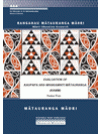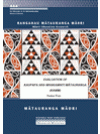Kaupapa Ara Whakawhiti Mätauranga (KAWM) encompassed a number of school improvement initiatives and aimed to:
- improve student achievement;
- improve school performance;
- strengthen school and community relationships;
- upgrade school ICT infrastructure; and
- improve teachers’ professional capability through ICT.
There were five school clusters within the umbrella of KAWM, and the strategies used to achieve the aims of KAWM were specific to the respective clusters involved. This evaluation focused on four of the five clusters.
- The wharekura cluster participated in all four aspects of KAWM. They received video conference kits with technical support, training for the wharekura e-teachers, laptops and professional development for their teachers, and school-based ICT infrastructure.
- The Paerangi schools’ cluster participated in three aspects of KAWM and received the video conference kits with technical support, laptops and professional development for teachers, and school-based ICT infrastructure.
- The Wairoa schools’ cluster and Kiwa (Gisborne) cluster participated in one aspect of KAWM only and received thin client networks with high-speed network connections and technical and learning facilitation support. This aspect, school-based ICT infrastructure, is called Project Rorohiko for the Wairoa and Kiwa clusters.
NZCER was contracted by the Ministry of Education to undertake an evaluation of the KAWM initiatives during 2002–03.
The key questions guiding this research were:
- What use is actually being made of each of these four aspects of KAWM? What factors lie behind any differences in use?
- What are the relationships between the uses being made of these three ICT tools, and the Wharekura Expert Teachers’ initiative, and wharekura and school curriculum organisation and content, teaching approaches, learning, student interest, teacher interest, motivation, retention, professional support and development, inter-school collaboration, school management, and community involvement and support for wharekura and schools?
- What are the conditions, skills, learning, and resources which allow the best use of KAWM, and, conversely, what are the conditions, skills, type and amount of learning, and resources, which inhibit its use, or which raise questions about its sustainability?
- What are the implications or lessons to be drawn from the initial implementation and use of KAWM for other policies and initiatives?
In 2002 and again in 2003 interviews with principals and teachers were undertaken in a total of six wharekura, three Paerangi schools, seven schools in the Kiwa cluster, and six in the Wairoa cluster. Twelve video conferencing classes and 59 ICT-related classes were observed. The findings from the first round of fieldwork in 2002 were reported in June 2003. This report draws on the findings of the fieldwork from both 2002 and 2003.


